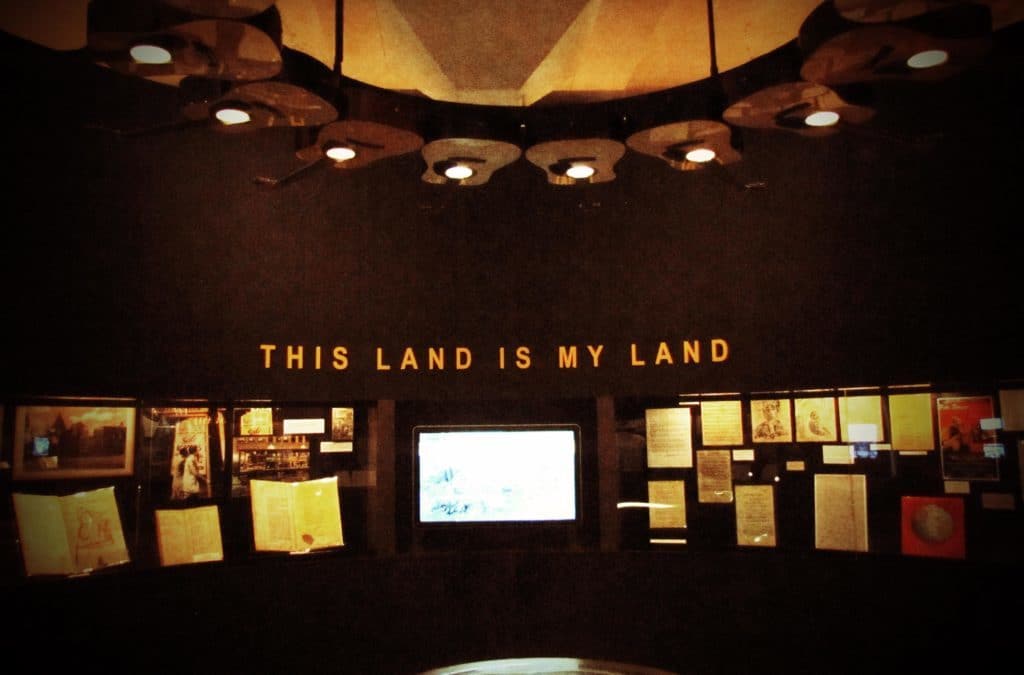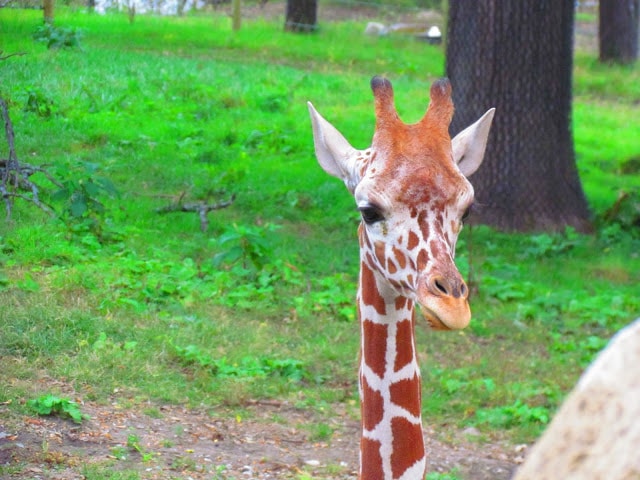A visit to Tulsa, Oklahoma offers a chance to immerse yourself in the culture of a Midwest city. At the Woody Guthrie Center you can learn about one of America’s greatest folksingers. Our visit occurred on a warm day in August. Of course, most days in August are going to be warm, since we are in the center of the United States. We like to think positive, so we had already prepared ourselves mentally for the weather. It sure beats torrential downpours.
We want to thank the Woody Guthrie Center for their hospitality. Rest assured that all opinions are our own.

Woody Guthrie Center
We arrived downtown, and found a decent parking spot in a nearby lot. We love exploring the downtown areas of cities, since it usually means we can connect a lot of places in one walking session. A quick stop at the Center of the Universe, (A “must experience” in Tulsa) and then we were off. The Woody Guthrie Center is in the Brady Arts District on the north side of the downtown area. There are lots of restaurants nearby, so it’s a great stop before or after lunch. The building is hard to miss, since it has a huge mural of Woody Guthrie on the side. This certainly makes for a great photo opportunity, as demonstrated by Crystal.

A Look Inside
To be honest, before our visit we knew very little about Woody Guthrie. We were aware that he authored “This Land is Your Land”, but had no real background knowledge of the man or his music. A visit to the Woody Guthrie Center was destined to fix this deficiency of knowledge. Visit Tulsa had arranged a tour for us, and we were met by Jerry Wofford, the Education and Public Programs Director. He was as excited to show off the center, as we were to see it. He gave us an overview of the museum’s layout, and then suggested we begin with the 14 minute video that details Woody’s beginnings. Our timing was perfect, and the video provided a solid base for exploring the museum’s exhibits.

Woody’s America
We love museums that feature interactive displays, and this one is certainly top notch in that area. After the video, we headed to the big screen exhibit titled “Woody’s America”. This touch screen display allows guests to dive deeper into Woody’s life story. Each touch brings up articles about his music. It also includes info about Tulsa, Oklahoma, and world history during Woody’s lifespan. I would rank this as one of the best designed displays I have seen in a museum setting. We would soon discover more unique audio-visual exhibits scattered throughout the center.

Disaster Strikes The Midwest
Across the hall from the interactive map, we found an alcove that highlighted the Dust Bowl period in the Central U.S. A video loop plays on one wall, and relates some of the story, as told in the Ken Burns documentary. Various displays show what was happening throughout the nation during this period. Alongside these displays is an audio exhibit where visitors can choose from a selection of songs Woody wrote and performed about the Dust Bowl. It is quite a sobering section, as you see the effects this man-made disaster had on families throughout the region.

Instruments Of Change
Moving toward the center of the museum, we found an assortment of Woody’s instruments on display. Among these was a fiddle that he carried with him during his stint in the U.S. Navy. The instrument even survived the sinking of the ship he was on. It was amusing to see the way that he decorated each of his musical instruments, and shows the lighthearted side of the man. There are other displays of his various stringed instruments, as well as some from other famous musicians that were affected by Woody’s music.

This Land
When most people think of Woody Guthrie, the song they remember is “This Land is My Land”. His music celebrates the beauty of the country from coast to coast. Woody wrote this song, because he was tired of “God Bless America” being overplayed on the radio. He wanted a more relevant theme, and adapted the words to the melody of an old gospel song. At the Woody Guthrie Center, you can listen to a recording of him singing this song. We were also able to see a copy of the original hand written lyrics. The original is kept on-site, but they only bring it out on special occasions. The rest of the time it is kept in an area that better preserves it from deterioration.

Additional Talents
Woody Guthrie was not just a musical artist. He also enjoyed painting and drawing. In the center of the building is where we found the “This Land” exhibit, and on the outside wall they have hung a collection of panels showcasing some of his drawings. He was known for being a political activist, and many ring with a cry for equality. The lyrics of many of his songs spoke out for the “little guy”, who was just trying to get by in life. This helped skyrocket his popularity with the working class, and soon he would use this stardom to help carry his message across the country, and beyond.

Special Guest Exhibits
The music of Woody Guthrie had a powerful effect on many of today’s popular artists. At the Woody Guthrie Center, we found that they have a section set aside for traveling exhibits on artists who collaborated with or found inspiration from Woody Guthrie. During our visit, the works of Pete Seger were being featured. Pete was a folk singer and activist from the same time period as Woody. Although we were not aware of his name, many of his tunes were also immediately recognizable. In a corner of the exhibit guests could do karaoke to a choice of Pete’s songs. While I didn’t belt out the lyrics, I did enjoy listening to his performance of “If I Had A Hammer”. I’m sure my refraining was appreciated by the other visitors that day. So now that you have had a peek at the Woody Guthrie Center, why not add it to your travel list? It’s just one of the many great stops we found in Tulsa Town.






Looks like a great place to visit my husband is a huge fan of Woody’s so will definitely get there when we get the the US
We think you will truly enjoy it.